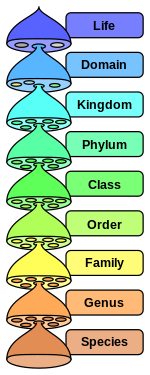Taxonomic Profiling
In the field of bioinformatics, taxonomy is a classification scheme which typically classifies each living organism into a heirarchical order composed of different levels such as domain, kingdom, phylum, etc. (Figure fig-taxo). This classification facilitates an understanding of micro-organism community structure at different levels, from coarse (e.g., phylum) to refine (e.g., species).

Taxonomic profiling predics taxonomic operational units present in the metagenomic sequences at different levels of classification. To perform this task, we will employ mOTUs tool (Ruscheweyh et al. 2021).
motus profile --forward <sample_R1.fastq> --reverse <sample_R2.fastq> --output motus_output_dir --db <path_to_mOTUs_database>Here, sample_R1.fastq and sample_R2.fastq are forward and backward reads. The results are stored in motus_output_dir specified using -output flag. The database of marker genes specified by <path_to_mOTUs_database>.